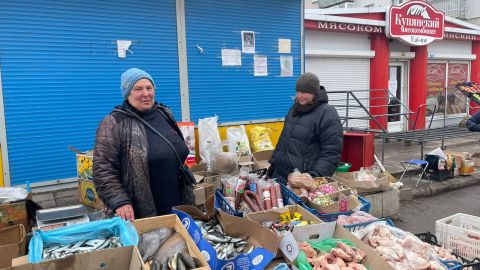Kupiansk, Ukraine CNN —
The artillery fire gets worse at night, so Liuba and her husband hold hands. It keeps them safe, she says with a sad nod of her head. She’s standing in what’s left of her garden after it was hit during a particularly bad night a month ago.
The shelling destroyed their neighbor’s home, throwing Liuba and her husband to the floor of their kitchen. Serhei, she says, landed with the fridge on top of him, thankfully more shaken than physically injured. Still, they will not go.
“This is our home,” Liuba told CNN. “Not the Russians’. Besides it’s getting warmer and with the rainwater we collect from buckets, we will survive.”

Liuba and Serhei, who gave only their first names for security reasons, are among the last remaining 2,500 residents of Kupiansk, a city in Ukraine’s northeastern Kharkiv region from which the front line has never strayed too far and to which the Ukrainian authorities fear it may be returning once again.
Kupiansk police chief Konstiantyn Tarasov says that ever since mid-February, the din of artillery – both the dull thud of outgoing and the sharper whistle of incoming fire – has been getting unnervingly closer. Russian positions are now less than 5 miles away from a city they occupied at the start of the invasion before losing it to Ukraine’s fall counteroffensive in September.
Last week, Ukrainian authorities ordered a mandatory evacuation of Kupiansk’s most vulnerable residents, due to “constant” Russian shelling.
“We have put signs up everywhere about the free evacuation with the phone numbers to call,” said Dmytro Kovalov, one of the volunteers involved in the evacuations.
“As shelling has intensified, more people have been registering. But then the internet was cut for two days so they couldn’t get in touch,” Kovalov told CNN. “That’s why we started just blindly visiting addresses, knocking on doors. But some people refuse to go. They don’t want to leave their houses behind, and they hope that the Russians will be pushed back.”
Authorities say that most days they manage anywhere from eight to 40 evacuations, although these remain voluntary.
As of last week, there were still 350 children and 363 people with disabilities inside the city, according to a spokesman for Kupiansk police. Beyond the repeated shelling, the city is also difficult to access because of the damage that more than a year of war has done to its infrastructure, including to many of the roads and bridges leading in and out.
The main market, too, has been reduced to rubble, forcing the city’s remaining residents to buy and sell whatever little they can on cardboard boxes that line a dirt track. Everything laid out can be easily packed up if the sound of shelling gets closer.

Lida, who piles of yellowed smoked fish among the produce laid out before her, has become an expert, she says, on the sound of outgoing and incoming artillery. She survived six months under the Russian occupation last year. She told CNN she will not be moved from Kupiansk this time either.
“We are not rats!” said Lida, who also gave only her first name for security reasons. “Besides, if we go, who will take over?”
About 100 yards from where she sits, Tarasov, the police chief, showed CNN what a Russian Grad missile did to a makeshift medicine dispensary just a few days earlier. But beyond the debris and the remnants of a missile, there isn’t much left to see. This, Tarasov said, is what the Russians do as they seek to move closer to the city center, targeting the few civilians left as they try to survive.
But Lida is unmoved.
“What’s the difference?” she asked. “They are shelling Kharkiv as well. Is there any certainty I will stay alive there? No. So, we will stay here and hide where we can, behind the houses, or somewhere.”
Most buildings bear the scars of the relentless attacks, and many are demolished. For the last couple of thousand civilians of Kupiansk, there aren’t that many places left to hide.
.png)
 1 year ago
7
1 year ago
7









 English (US) ·
English (US) ·